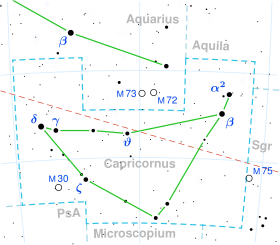| Observation data Epoch J2000.0 Equinox J2000.0 (ICRS) | |
|---|---|
| Constellation | Capricornus |
| Right ascension | 20h 28m 51.61448s[1] |
| Declination | −17° 48′ 49.2693″[1] |
| Apparent magnitude (V) | +4.78[2] (4.97 + 6.88)[3] |
| Characteristics | |
| Spectral type | F2 IV[2] + G1[4] |
| Astrometry | |
| Radial velocity (Rv) | +18.4[5] km/s |
| Proper motion (μ) | RA: −14.98[1] mas/yr Dec.: −7.29[1] mas/yr |
| Parallax (π) | 33.04 ± 0.46 mas[1] |
| Distance | 99 ± 1 ly (30.3 ± 0.4 pc) |
| Absolute magnitude (MV) | 2.52 + 4.56[4] |
| Orbit[3] | |
| Period (P) | 278 yr |
| Semi-major axis (a) | 1.877″ |
| Eccentricity (e) | 0.91 |
| Inclination (i) | 113.3° |
| Longitude of the node (Ω) | 162.0° |
| Periastron epoch (T) | 1965.0 |
| Argument of periastron (ω) (secondary) | 144.5° |
| Details[6] | |
| ρ Cap A | |
| Mass | 1.52±0.04 M☉ |
| Radius | 1.3[2] R☉ |
| Luminosity | 9[7] L☉ |
| Surface gravity (log g) | 4.02±0.03 cgs |
| Temperature | 6,911±63 K |
| Metallicity [Fe/H] | −0.20±0.05 dex |
| Rotational velocity (v sin i) | 87.7[8] km/s |
| Age | 1.74±0.15 Gyr |
| Other designations | |
| Database references | |
| SIMBAD | ρ Cap |
| ρ Cap A | |
| ρ Cap B | |
| ARICNS | ρ Cap A |
| ρ Cap B | |
Rho Capricorni (ρ Cap, ρ Capricorni) is a binary star[3] in the constellation Capricornus. Sometimes, this star is called by the name Bos, meaning the cow in Latin.[10] In Chinese, 牛宿 (Niú Su), meaning Ox (asterism), refers to an asterism consisting of β Capricorni, α2 Capricorni, ξ2 Capricorni, π Capricorni, ο Capricorni and ρ Capricorni.[11] Consequently, the Chinese name for ρ Capricorni itself is 牛宿六 (Niú Su liù, English: the Sixth Star of Ox.)[12]
This system is visible to the naked eye with a combined apparent visual magnitude of +4.78.[2] The pair orbit each other with a period of 278 years and an eccentricity of 0.91.[3] Based upon an annual parallax shift of 33.04 mas as seen from the Earth,[1] the system is located about 99 light years from the Sun. It is a thin disk population[6] star system that made its closest approach to the Sun about 1.6 million years ago when it came within 12.49 ly (3.830 pc).[13]
The primary member, component A, is a yellow-white hued, F-type subgiant with an apparent magnitude of 4.97[3] and a stellar classification of F2 IV.[2] This star has 1.5[6] times the mass of the Sun and 1.3 times the Sun's radius. It is radiating 9 times[7] as much luminosity of the Sun from its outer atmosphere at an effective temperature of 6,911 K.[6] The companion, component B, has a visual magnitude of 6.88.[3] The mass ratio is 0.539, meaning the secondary is only 53.9% as massive as the primary.[14]
- ^ a b c d e f Cite error: The named reference
vanLeeuwen2007was invoked but never defined (see the help page). - ^ a b c d e Cite error: The named reference
aass85_3_1015was invoked but never defined (see the help page). - ^ a b c d e f Cite error: The named reference
orb6was invoked but never defined (see the help page). - ^ a b Cite error: The named reference
Cvetkovic2010was invoked but never defined (see the help page). - ^ Cite error: The named reference
Wilson1953was invoked but never defined (see the help page). - ^ a b c d Cite error: The named reference
Ramirez2012was invoked but never defined (see the help page). - ^ a b Cite error: The named reference
McDonald2012was invoked but never defined (see the help page). - ^ Cite error: The named reference
Schroeder2009was invoked but never defined (see the help page). - ^ Cite error: The named reference
SIMBADwas invoked but never defined (see the help page). - ^ Cite error: The named reference
CoWwas invoked but never defined (see the help page). - ^ (in Chinese) 中國星座神話, written by 陳久金. Published by 台灣書房出版有限公司, 2005, ISBN 978-986-7332-25-7.
- ^ (in Chinese) AEEA (Activities of Exhibition and Education in Astronomy) 天文教育資訊網 2006 年 5 月 13 日
- ^ Cite error: The named reference
aa575_A35was invoked but never defined (see the help page). - ^ Cite error: The named reference
Makarovwas invoked but never defined (see the help page).
